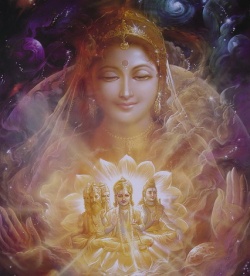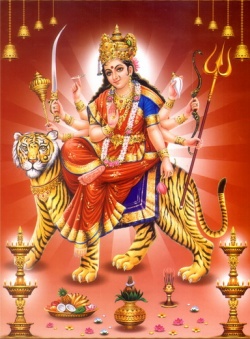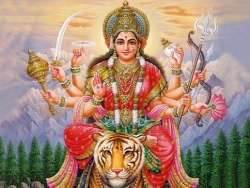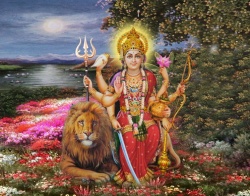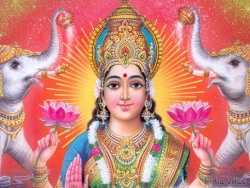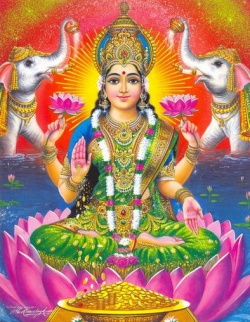Difference between revisions of "Devi"
m (1 revision: Robo 2.48 15 septmeber replacetext) |
m (Text replacement - "Vedic" to "{{Wiki|Vedic}}") |
||
| Line 1: | Line 1: | ||
[[File:Devi_trinity.jpg|thumb|250px|]] | [[File:Devi_trinity.jpg|thumb|250px|]] | ||
<poem> | <poem> | ||
| − | Devī ({{Wiki|Devanagari}}: देवी) is the [[Sanskrit]] root-word of [[Divine]], its related {{Wiki|masculine}} term is [[Deva]]. [[Devi]] is {{Wiki|synonymous}} with [[Shakti]], the {{Wiki|female}} aspect of the [[divine]], as [[conceptualized]] by the {{Wiki|Shakta}} [[tradition]] of [[Hinduism]]. She is the {{Wiki|female}} counterpart without whom the {{Wiki|male}} aspect, which represents [[Consciousness]] or | + | Devī ({{Wiki|Devanagari}}: देवी) is the [[Sanskrit]] root-word of [[Divine]], its related {{Wiki|masculine}} term is [[Deva]]. [[Devi]] is {{Wiki|synonymous}} with [[Shakti]], the {{Wiki|female}} aspect of the [[divine]], as [[conceptualized]] by the {{Wiki|Shakta}} [[tradition]] of [[Hinduism]]. She is the {{Wiki|female}} counterpart without whom the {{Wiki|male}} aspect, which represents [[Consciousness]] or {{Wiki|discrimination}}, {{Wiki|remains}} impotent and [[void]]. [[Goddess]] worship is an integral part of [[Hinduism]]. |
[[Devi]] is, quintessentially, the core [[Form]] of every [[Hindu]] [[Goddess]]. As the {{Wiki|female}} [[manifestation]] of the [[supreme]] [[Lord]], she is also called Prakriti, as she balances out the {{Wiki|male}} aspect of the [[divine]] addressed {{Wiki|Purusha}}. | [[Devi]] is, quintessentially, the core [[Form]] of every [[Hindu]] [[Goddess]]. As the {{Wiki|female}} [[manifestation]] of the [[supreme]] [[Lord]], she is also called Prakriti, as she balances out the {{Wiki|male}} aspect of the [[divine]] addressed {{Wiki|Purusha}}. | ||
| Line 12: | Line 12: | ||
The {{Wiki|Indus}} Valley {{Wiki|Civilization}}, with its neighboring cultures of Zhob and Kulli regions in Balochistan, have yielded {{Wiki|data}} on prehistoric [[religious]] practices on the [[Indian]] subcontinent dating back to 3000 BC. Some [[scholars]] suggest that the {{Wiki|Indus}} Valley {{Wiki|culture}} has a cult of the Great Mother or the [[Divine Mother]], similar to such cults in {{Wiki|Persia}} (Anahita), {{Wiki|Asia}} Minor and the Mediterranean; and some have even speculated that this may be the earliest [[Form]] of [[Shaktism]]. | The {{Wiki|Indus}} Valley {{Wiki|Civilization}}, with its neighboring cultures of Zhob and Kulli regions in Balochistan, have yielded {{Wiki|data}} on prehistoric [[religious]] practices on the [[Indian]] subcontinent dating back to 3000 BC. Some [[scholars]] suggest that the {{Wiki|Indus}} Valley {{Wiki|culture}} has a cult of the Great Mother or the [[Divine Mother]], similar to such cults in {{Wiki|Persia}} (Anahita), {{Wiki|Asia}} Minor and the Mediterranean; and some have even speculated that this may be the earliest [[Form]] of [[Shaktism]]. | ||
| − | The | + | The {{Wiki|Vedic}} {{Wiki|literature}} describes a number of significant [[goddesses]] including Ushas, [[Prithivi]], Aditi, [[Saraswati]], Vac, Nirrti, Ratri, Aranyani; and a number of minor ones, including Puramdhi, Parendi, Raka, Dhisana, – hardly mentioned about a dozen times in the {{Wiki|Rig Veda}}, and they all are associated with bounties and riches. Few others like Ila, Bharati, Mahi, Hotra are invoked and summoned through hymns to take their share during certain [[Rituals]]. |
According to the [[Vedas]], [[Shakti]] is claimed to be [[Maya]] or [[Illusion]] that casts a veil over [[Brahman]], the [[Ultimate reality]]. [[Shakti]] and [[Brahman]] are inseparable entities that lie in a single [[Body]] which reaffirms the claim that [[Shakti]] and [[Shiva]] coexist. | According to the [[Vedas]], [[Shakti]] is claimed to be [[Maya]] or [[Illusion]] that casts a veil over [[Brahman]], the [[Ultimate reality]]. [[Shakti]] and [[Brahman]] are inseparable entities that lie in a single [[Body]] which reaffirms the claim that [[Shakti]] and [[Shiva]] coexist. | ||
| Line 25: | Line 25: | ||
In the [[Hindu]] {{Wiki|pantheon}}, {{Wiki|Durga}} is one of the most popular [[goddesses]], and her creation takes place in the context of a [[cosmic]] crisis. The [[Asuras]] were on the [[ascent]], and they had become a threat to [[cosmic]] stability. The {{Wiki|male}} [[gods]] were unable to contain and subdue them. A number of {{Wiki|male}} [[gods]] having failed to subdue the [[demons]] led by {{Wiki|Mahishasura}}, assembled into a conclave and emitted their energies together which took the [[Form]] of the [[warrior]] [[goddess]], {{Wiki|Durga}}, that is, the [[invincible]]. | In the [[Hindu]] {{Wiki|pantheon}}, {{Wiki|Durga}} is one of the most popular [[goddesses]], and her creation takes place in the context of a [[cosmic]] crisis. The [[Asuras]] were on the [[ascent]], and they had become a threat to [[cosmic]] stability. The {{Wiki|male}} [[gods]] were unable to contain and subdue them. A number of {{Wiki|male}} [[gods]] having failed to subdue the [[demons]] led by {{Wiki|Mahishasura}}, assembled into a conclave and emitted their energies together which took the [[Form]] of the [[warrior]] [[goddess]], {{Wiki|Durga}}, that is, the [[invincible]]. | ||
| − | + | {{Wiki|Vedic}} {{Wiki|literature}} does not have any particular [[goddess]] matching the {{Wiki|concept}} of {{Wiki|Durga}} though it has references to certain [[goddesses]] as slayers of [[demons]]. Taitriya-aranyaka mentions {{Wiki|Durga}}, but not in a [[manner]] comparable to {{Wiki|Durga}} of later [[Hinduism]]. Around the 4th century AD, images of {{Wiki|Durga}} slaying {{Wiki|Mahishasura}} begin to become common in many palaces in the [[Indian]] subcontinent. | |
The {{Wiki|theology}} underlying Durga’s [[emergence]] and exploits are revealed in [[Devi]] Mahatmyam, the most famous text extolling her exploits, and is described: "Though she is [[eternal]], the [[goddess]] becomes [[manifest]] over and over again to protect the [[World]]". This makes her on par with various [[Avatars]] of [[Vishnu]]. | The {{Wiki|theology}} underlying Durga’s [[emergence]] and exploits are revealed in [[Devi]] Mahatmyam, the most famous text extolling her exploits, and is described: "Though she is [[eternal]], the [[goddess]] becomes [[manifest]] over and over again to protect the [[World]]". This makes her on par with various [[Avatars]] of [[Vishnu]]. | ||
| Line 32: | Line 32: | ||
[[Saraswati]] | [[Saraswati]] | ||
| − | [[Saraswati]], the flowing one, is one of the most celebrated [[goddesses]] from the | + | [[Saraswati]], the flowing one, is one of the most celebrated [[goddesses]] from the {{Wiki|Vedic}} period through current times. She has been repeatedly mentioned in the {{Wiki|Rig Veda}}, and has been identified with the [[Saraswati]] [[River]]. Over a period of [[time]], in later [[Hinduism]], her connection with a [[river]] decreased considerably, and she is no longer a [[goddess]] who [[embodies]] sacrality of a [[river]], but has acquired her independent {{Wiki|history}} and attributes. |
[[File:Durga-Devi.jpg|thumb|250px|]] | [[File:Durga-Devi.jpg|thumb|250px|]] | ||
She is the [[goddess]] of [[speech]] and {{Wiki|learning}}, and is the [[creator]] of [[Sanskrit]], the [[Language]] of the [[Vedas]]. She is the [[consort]] of [[Brahma]], the [[creator]] and member of the [[Hindu]] Trinity. She is equally revered by [[Hindus]], {{Wiki|Jains}} and the [[Buddhists]]. Her {{Wiki|iconography}} depicts her association with [[Art]], [[science]] and {{Wiki|culture}}, which is dramatically different from some other major [[goddesses]] who are identified with {{Wiki|fertility}}, [[Wealth]], and battles. She is shown as having four arms, and the most common items held by her in her hands are a [[book]], a vina (lute), a [[Mala]], and a [[water]] pot. The [[book]] signified [[Art]], [[science]] and {{Wiki|learning}}; the vina associates her with {{Wiki|music}} and performing arts; and the [[prayer]] beads and [[water]] pot signify her association with [[religious]] [[rites]]. She is worshipped on the fifth day of the spring according to [[Hindu]] [[Calendar]], called the Basant Panchami. | She is the [[goddess]] of [[speech]] and {{Wiki|learning}}, and is the [[creator]] of [[Sanskrit]], the [[Language]] of the [[Vedas]]. She is the [[consort]] of [[Brahma]], the [[creator]] and member of the [[Hindu]] Trinity. She is equally revered by [[Hindus]], {{Wiki|Jains}} and the [[Buddhists]]. Her {{Wiki|iconography}} depicts her association with [[Art]], [[science]] and {{Wiki|culture}}, which is dramatically different from some other major [[goddesses]] who are identified with {{Wiki|fertility}}, [[Wealth]], and battles. She is shown as having four arms, and the most common items held by her in her hands are a [[book]], a vina (lute), a [[Mala]], and a [[water]] pot. The [[book]] signified [[Art]], [[science]] and {{Wiki|learning}}; the vina associates her with {{Wiki|music}} and performing arts; and the [[prayer]] beads and [[water]] pot signify her association with [[religious]] [[rites]]. She is worshipped on the fifth day of the spring according to [[Hindu]] [[Calendar]], called the Basant Panchami. | ||
| Line 41: | Line 41: | ||
Shri, commonly known as [[Lakshmi]] and also called Shri [[Lakshmi]], is one of the most popular and widely worshipped [[Devi]] in [[Hindu]] [[tradition]] since pre-Buddhist period. Her [[name]] is the basis for "Lady [[Luck]] ([[Lakshmi]])" in the {{Wiki|Christian}} {{Wiki|West}} and her [[Form]] of rising from [[water]] is depicted as {{Wiki|Venus}}. She has a considerable [[Body]] of [[mythology]] and {{Wiki|history}}. The earliest legend states that Shri is born as a result of austerities of {{Wiki|Prajapati}}, and she represents ten qualities and [[objects]], namely, [[Food]], {{Wiki|royal}} [[Power]], [[universal]] sovereignty, [[Knowledge]], [[Power]], holy luster, {{Wiki|kingdom}}, [[Fortune]], bounteousness, and [[Beauty]]. | Shri, commonly known as [[Lakshmi]] and also called Shri [[Lakshmi]], is one of the most popular and widely worshipped [[Devi]] in [[Hindu]] [[tradition]] since pre-Buddhist period. Her [[name]] is the basis for "Lady [[Luck]] ([[Lakshmi]])" in the {{Wiki|Christian}} {{Wiki|West}} and her [[Form]] of rising from [[water]] is depicted as {{Wiki|Venus}}. She has a considerable [[Body]] of [[mythology]] and {{Wiki|history}}. The earliest legend states that Shri is born as a result of austerities of {{Wiki|Prajapati}}, and she represents ten qualities and [[objects]], namely, [[Food]], {{Wiki|royal}} [[Power]], [[universal]] sovereignty, [[Knowledge]], [[Power]], holy luster, {{Wiki|kingdom}}, [[Fortune]], bounteousness, and [[Beauty]]. | ||
| − | Shri appears in several | + | Shri appears in several {{Wiki|Vedic}} hymns, and Shri is indicative of several positive attributes including [[Beauty]], glory, [[Power]], capability, and [[higher]] rank. In later {{Wiki|Vedic}} {{Wiki|literature}}, Shri signified the ruling [[Power]] and the majesty of [[kings]]. Shri-Sukt, a hymn appended to the {{Wiki|Rig Veda}}, is a famous {{Wiki|Vedic}} [[chant]], extolling Shri, and presents a detailed account of her, both conceptually and visually. The hymn also associates her with [[Lotus]] and [[elephant]] – an association, which has not changed in subsequent {{Wiki|history}}. |
By the late epic period (400 AD), [[Lakshmi]] became associated with [[Vishnu]], and emerged as his wife or [[consort]], and acquired - in addition to her earlier attributes - characteristics of a model wife. | By the late epic period (400 AD), [[Lakshmi]] became associated with [[Vishnu]], and emerged as his wife or [[consort]], and acquired - in addition to her earlier attributes - characteristics of a model wife. | ||
| Line 72: | Line 72: | ||
Sita is one of the most popular [[divinities]] of [[Hinduism]]. Currently, Sita is associated with {{Wiki|Rama}} (an [[Avatar]] of [[Vishnu]]) as his wife, and she receives worship along with her husband {{Wiki|Rama}}. She is one of the many [[incarnations]] of [[Lakshmi]]. | Sita is one of the most popular [[divinities]] of [[Hinduism]]. Currently, Sita is associated with {{Wiki|Rama}} (an [[Avatar]] of [[Vishnu]]) as his wife, and she receives worship along with her husband {{Wiki|Rama}}. She is one of the many [[incarnations]] of [[Lakshmi]]. | ||
| − | A {{Wiki|female}} [[divinity]] called Sita was known before the {{Wiki|Ramayana}} of Valmiki. Sita literally means “furrow”, that is, the line made while plowing the land, and in | + | A {{Wiki|female}} [[divinity]] called Sita was known before the {{Wiki|Ramayana}} of Valmiki. Sita literally means “furrow”, that is, the line made while plowing the land, and in {{Wiki|Vedic}} period, she was one of the [[goddesses]] associated with {{Wiki|fertility}}. The Kausik-[[Sutra]] and the Paraskara-[[Sutra]] associates her repeatedly as the wife of Parjanya (a [[God]] associated with rains) and [[Indra]]. |
She emerged as a significant [[divinity]] with Valmiki’s {{Wiki|Ramayana}}, written sometime between 200 BC and 200 AD, and various vernacular renditions of the same, with slightly modified contents, over next several centuries. These texts extol {{Wiki|Rama}} and Sita as the [[divine]] couple, and countless [[mythology]], legend, and folklores revolve around them. Sita is always represented in association with {{Wiki|Rama}}, her husband, and {{Wiki|Rama}} is central to her [[Life]] and [[existence]]. She has the dominant role of all [[Hindu]] [[mythological]] [[tradition]] as far as the portrayal of {{Wiki|ideal}} woman and {{Wiki|ideal}} wife is concerned. She represents wifely devotion, [[forbearance]] and chastity. She overshadows several other [[divine]] [[Hindu]] wives including {{Wiki|Parvati}} and [[Lakshmi]], and other similar devoted wives of [[Hindu]] [[mythology]] like [[Savitri]] and Damayanti. | She emerged as a significant [[divinity]] with Valmiki’s {{Wiki|Ramayana}}, written sometime between 200 BC and 200 AD, and various vernacular renditions of the same, with slightly modified contents, over next several centuries. These texts extol {{Wiki|Rama}} and Sita as the [[divine]] couple, and countless [[mythology]], legend, and folklores revolve around them. Sita is always represented in association with {{Wiki|Rama}}, her husband, and {{Wiki|Rama}} is central to her [[Life]] and [[existence]]. She has the dominant role of all [[Hindu]] [[mythological]] [[tradition]] as far as the portrayal of {{Wiki|ideal}} woman and {{Wiki|ideal}} wife is concerned. She represents wifely devotion, [[forbearance]] and chastity. She overshadows several other [[divine]] [[Hindu]] wives including {{Wiki|Parvati}} and [[Lakshmi]], and other similar devoted wives of [[Hindu]] [[mythology]] like [[Savitri]] and Damayanti. | ||
Revision as of 13:39, 16 September 2013
Devī (Devanagari: देवी) is the Sanskrit root-word of Divine, its related masculine term is Deva. Devi is synonymous with Shakti, the female aspect of the divine, as conceptualized by the Shakta tradition of Hinduism. She is the female counterpart without whom the male aspect, which represents Consciousness or discrimination, remains impotent and void. Goddess worship is an integral part of Hinduism.
Devi is, quintessentially, the core Form of every Hindu Goddess. As the female manifestation of the supreme Lord, she is also called Prakriti, as she balances out the male aspect of the divine addressed Purusha.
Devi is the supreme Being in the Shaktism tradition of Hinduism, while in the Smartha tradition, she is one of the five primary forms of God. In other Hindu traditions of Shaivism and Vaishnavism, Devi embodies the active energy and Power of male deities (Purushas), such as Vishnu in Vaishnavism or Shiva in Shaivism. Vishnu's Shakti counterpart is called Lakshmi, with Parvati being the female Shakti of Shiva.
Origins
Indus Valley
The Indus Valley Civilization, with its neighboring cultures of Zhob and Kulli regions in Balochistan, have yielded data on prehistoric religious practices on the Indian subcontinent dating back to 3000 BC. Some scholars suggest that the Indus Valley culture has a cult of the Great Mother or the Divine Mother, similar to such cults in Persia (Anahita), Asia Minor and the Mediterranean; and some have even speculated that this may be the earliest Form of Shaktism.
The Vedic literature describes a number of significant goddesses including Ushas, Prithivi, Aditi, Saraswati, Vac, Nirrti, Ratri, Aranyani; and a number of minor ones, including Puramdhi, Parendi, Raka, Dhisana, – hardly mentioned about a dozen times in the Rig Veda, and they all are associated with bounties and riches. Few others like Ila, Bharati, Mahi, Hotra are invoked and summoned through hymns to take their share during certain Rituals.
According to the Vedas, Shakti is claimed to be Maya or Illusion that casts a veil over Brahman, the Ultimate reality. Shakti and Brahman are inseparable entities that lie in a single Body which reaffirms the claim that Shakti and Shiva coexist.
Manifestations
Devi or the divine feminine is an equal conterpart to the divine masculine, and hence manifests herself as the Trinity herself - the Creator (Durga or the Divine Mother), Preserver (Lakshmi, Parvati & Saraswati) and Destroyer (Mahishasura-Mardini, Kali & Smashanakali ).
Mahadevi
Many texts, myths and Rituals concerning goddesses subsume them all under one great female being, named generally as Mahadevi or Devi. Early Hindu traditions as reflected in the Vedas speak of discrete goddesses like Parvati and Lakshmi. Later, there emerged a tendency to relate all goddesses to one ultimate goddess, the best example of such texts being the Devi Mahatamaya. Another important feature of Mahadevi mythology and theology is the insistence that assumes both benign and terrible aspects of Mahadevi.
Durga
In the Hindu pantheon, Durga is one of the most popular goddesses, and her creation takes place in the context of a cosmic crisis. The Asuras were on the ascent, and they had become a threat to cosmic stability. The male gods were unable to contain and subdue them. A number of male gods having failed to subdue the demons led by Mahishasura, assembled into a conclave and emitted their energies together which took the Form of the warrior goddess, Durga, that is, the invincible.
Vedic literature does not have any particular goddess matching the concept of Durga though it has references to certain goddesses as slayers of demons. Taitriya-aranyaka mentions Durga, but not in a manner comparable to Durga of later Hinduism. Around the 4th century AD, images of Durga slaying Mahishasura begin to become common in many palaces in the Indian subcontinent.
The theology underlying Durga’s emergence and exploits are revealed in Devi Mahatmyam, the most famous text extolling her exploits, and is described: "Though she is eternal, the goddess becomes manifest over and over again to protect the World". This makes her on par with various Avatars of Vishnu.
One of the most famous festivals associated with her is Durga Puja celebrated in the month of Ashvin (September–October), and is also called the Navaratri festival.
Saraswati
Saraswati, the flowing one, is one of the most celebrated goddesses from the Vedic period through current times. She has been repeatedly mentioned in the Rig Veda, and has been identified with the Saraswati River. Over a period of time, in later Hinduism, her connection with a river decreased considerably, and she is no longer a goddess who embodies sacrality of a river, but has acquired her independent history and attributes.
She is the goddess of speech and learning, and is the creator of Sanskrit, the Language of the Vedas. She is the consort of Brahma, the creator and member of the Hindu Trinity. She is equally revered by Hindus, Jains and the Buddhists. Her iconography depicts her association with Art, science and culture, which is dramatically different from some other major goddesses who are identified with fertility, Wealth, and battles. She is shown as having four arms, and the most common items held by her in her hands are a book, a vina (lute), a Mala, and a water pot. The book signified Art, science and learning; the vina associates her with music and performing arts; and the prayer beads and water pot signify her association with religious rites. She is worshipped on the fifth day of the spring according to Hindu Calendar, called the Basant Panchami.
Shri-Lakshmi
Lakshmi
Shri, commonly known as Lakshmi and also called Shri Lakshmi, is one of the most popular and widely worshipped Devi in Hindu tradition since pre-Buddhist period. Her name is the basis for "Lady Luck (Lakshmi)" in the Christian West and her Form of rising from water is depicted as Venus. She has a considerable Body of mythology and history. The earliest legend states that Shri is born as a result of austerities of Prajapati, and she represents ten qualities and objects, namely, Food, royal Power, universal sovereignty, Knowledge, Power, holy luster, kingdom, Fortune, bounteousness, and Beauty.
Shri appears in several Vedic hymns, and Shri is indicative of several positive attributes including Beauty, glory, Power, capability, and higher rank. In later Vedic literature, Shri signified the ruling Power and the majesty of kings. Shri-Sukt, a hymn appended to the Rig Veda, is a famous Vedic chant, extolling Shri, and presents a detailed account of her, both conceptually and visually. The hymn also associates her with Lotus and elephant – an association, which has not changed in subsequent history.
By the late epic period (400 AD), Lakshmi became associated with Vishnu, and emerged as his wife or consort, and acquired - in addition to her earlier attributes - characteristics of a model wife.
She is worshiped on Diwali, a new moon night, to symbolize that her presence is enough to dispel all the darkness from the hearts of her devotees.
Parvati
Parvati is the daughter of the mountains (the Himalayas), and manifests the aspect of the goddess as the wife of Shiva. She is generally considered a benign goddess. She is one of the principal deities of Shaktism and sometimes considered the essence of Shakti herself, i.e. Adi-Shakti. She has been identified as a Reincarnation of Dakshayani or Sati, Shiva’s first wife, who destroyed her by self-immolation because her father, Daksha, had insulted Shiva. Parvati, when depicted alongside Shiva, appears with two arms, but when alone, she is shown having four arms, and riding a tiger or lion. She is also known by a number of other names, including Durga (Goddess Beyond reach)Ambika (mother), Gauri (golden), Shyama (dark complexioned), Bhavani (Mother of Universe) Bhairavi (awesome) and Kali (black-colored or Goddess of Time). She is also identified as Mahadevi.
In classical Hindu mythology, the raison d’être of Parvati, and before that of Sati, is to lure Shiva into marriage and thus into a wider circle of worldly affairs. With the plays of Kalidas (5th-6th centuries) and the {{Wiki|Puranas]] (4th through the 13th centuries) the myths of Sati, Parvati and Shiva acquired comprehensive details.
Kali
Kali is one of the most significant divinities, and many texts and contexts treat Kali as an independent deity, not directly associated with a male God. In case she is associated with a male God, it is invariably Shiva. In this aspect, she represents the omnipotent Shakti of Shiva. She holds both the creative and destructive Power of time.
The earliest reference to Kali in Hindu tradition date back to the 6th century, and locate her in the battle fields fighting Asuras. Her temples are recommended to be built away from human habitations. Vana Bhatta's 7th century drama Kadambari features a goddess named Chandi, an Epithet of both Kali and Durga.
Kali’s most famous appearance in battle contexts are found in the Devi Mahatmya when during the battle with Asuras, Durga becomes angry. Her face turns pitch dark, and suddenly Kali springs forth from Durga’s forehead. She is black, wears a garland of human heads, is clothed in a tiger skin, and wields a staff topped by a human skull. She destroys the Asuras. Later, Durga seeks her assistance once more to annihilate Raktabija. Kali’s mythology recounts several such Appearances, mostly in terrible aspects.
Mahavidya
Mahavidyas, that is, the supreme Knowledge, revelations and manifestations, refer to a group of ten goddesses. They constitute an important aspect of Mahadevi theology, which emphasizes that the Devi has a tendency to manifest and display herself in a variety of forms and aspects. Mahavidyas find no mention in the earliest Hindu texts, but appeared relatively late in Hindu tradition. Seven of them represent creative forces embodies in Kali, and the remaining three embody her destructive nature and aspects. In the context of Hindu mythology, the origin of the ten Mahavidyas takes place in the story of Sati and Shiva.
Ten Mahavidyas are: Kali, Tara, Chinnamasta, Bhuvanesvari, Bagla, Dhumavati, Kamla, Matangi, Sodasi, and Bhairavi.
Navadurga
Navadurga (Devanagari: नवदुर्गा), which literally means nine Durgas, constitute, according to Hindu mythology, the manifestation of Durga in nine different forms. Navadurga are famously worshipped during the Autumn Navaratri or the Nine days, initiating the devotees into a period of festivities according to Hindu Calendar.
Other aspects
Sita
Sita is one of the most popular divinities of Hinduism. Currently, Sita is associated with Rama (an Avatar of Vishnu) as his wife, and she receives worship along with her husband Rama. She is one of the many incarnations of Lakshmi.
A female divinity called Sita was known before the Ramayana of Valmiki. Sita literally means “furrow”, that is, the line made while plowing the land, and in Vedic period, she was one of the goddesses associated with fertility. The Kausik-Sutra and the Paraskara-Sutra associates her repeatedly as the wife of Parjanya (a God associated with rains) and Indra.
She emerged as a significant divinity with Valmiki’s Ramayana, written sometime between 200 BC and 200 AD, and various vernacular renditions of the same, with slightly modified contents, over next several centuries. These texts extol Rama and Sita as the divine couple, and countless mythology, legend, and folklores revolve around them. Sita is always represented in association with Rama, her husband, and Rama is central to her Life and existence. She has the dominant role of all Hindu mythological tradition as far as the portrayal of ideal woman and ideal wife is concerned. She represents wifely devotion, forbearance and chastity. She overshadows several other divine Hindu wives including Parvati and Lakshmi, and other similar devoted wives of Hindu mythology like Savitri and Damayanti.
Her current history states that she emerged from the earth when king Janaka was plowing the field during a Ritual to invoke rains. She was married to Rama, was abducted by Ravana, reclaimed by Rama, and then banished out of his kingdom. In the forests, in an ashram of Valmiki, she raised her two sons, Kusha and Lava, who engaged the royal forces of Rama and inflicted heavy damage. Rama himself comes to fight with them, when Valmiki told him that they were his own sons. Rama requests Sita to come back, but remembering the injustices meted out to her, she called her mother Earth to receive her back, the ground opens up and she returned to where she had originally emerged.
Radha
Radha, which means prosperity and success, is one of the Gopis of Vrindavan, and is a central figure of Vaishnava theology. Early literature speaks of a favourite Gopi of Krishna, but her details emerge clearly centuries later. Jayadeva’s Gitagovinda (12th century) presents a full depiction of Radha and her association with Krishna.
In fact, Radha is the original manifestation of Param(Adi) Shakti, i.e. Parvati (in sagun-i.e. benevolent-Form), which is the supreme energy in the Hindu Religion. She is same as mother Sita is who worshiped Goddess Gauri, whose partial incarnations are Lakshmi, Durga and Saraswati. In order to please Parasiva, one has to first please Adi parashakti. So In order to please Krishna, one has to call Radha first. In Devi Bhagavata, it is mentioned that she is the one who fulfills all the desires of all creatures by simply crying while remembering her and She is the partial expansion of Parvati, actual source all energies.
Traditionally, Radha’s Love for Krishna is likened to human soul’s yearning for God, and she is regarded as an ultimate model for devotees. Her role is also to be an intermediary between man and God.
Matrikas
Matrikas, that is, the mothers, are a band of divinities, which always appear in a group.
Shakti Peethas
Another important aspects of the Female divine are the various Shakti Peethas spread all across the nation, where over 51 Body parts of Devi Sati, first wife of Lord Shiva fell after being broken apart by the Sudarshana Chakra of Lord Vishnu.
Goddess Sati had earlier performed self-immolation at the ceremonial feast of her father king Daksha and an enraged and inconsolable Lord Shiva was wandering all over the Creation, with her dead Body, threatening its very existence. Each point on the earth where her Body parts fell is now venerated as a Shakti Peetha - the seat of Shakti or female Power.
